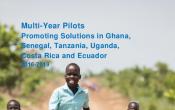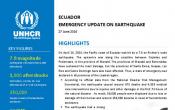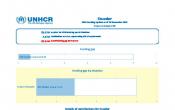Ecuador
Operation: Ecuador
Location
{"longitude":-78,"latitude":-2,"zoom_level":7}
Latest update of camps and office locations 21 Nov 2016. By clicking on the icons on the map, additional information is displayed.
Key Figures
| 2016 end-year results | |
| 40,000 | peope affected by the April 2016 earthquake benefited from core relief items and protection interventions |
| 10,020 | PoC with specific needs were assisted |
| 5,280 | PoC were enrolled in the graduation approach programme |
| 5,250 | PoC received legal assistance and information on the RSD process |
| 770 | individuals departed for resettlement |
| 700 | PoC accessed migratory alternatives, such as MERCOSUR or family (Amparo) residence visas |
| 2017 planning figures | |
| 20,000 | recognized refugees will be enrolled in the Civil Registry database |
| 1,000 | vulnerable people of concern are submitted for resettlement to third countries |
| 65% | of people of concern have legal status as refugees or alternative migratory options |
| 50% | of households of concern have an income above the poverty line, which is USD81 per capita per month |
| 25% | of people of concern use banking services, such as loans, bank transfers, and savings accounts |
Latest Updates
People of Concern
4%
Decrease in
2016
2016
| 2016 | 127,390 |
| 2015 | 133,118 |
| 2014 | 133,744 |

[["Refugees",60524],["Refugee-like situation",42324],["Asylum-seekers",24542]]
Loading ...
Ecuador
< Back
2016
{"categories":[2012,2013,2014,2015,2016,2017],"budget":[21.10040526,21.17873588,20.97998614,22.04358705,25.03556459,21.76300035],"expenditure":[12.69309262,11.64044185,12.05890811,12.67403558,14.30981715,null]}
{"categories":[2012,2013,2014,2015,2016,2017],"p1":[21.10040526,21.17873588,20.97998614,22.04358705,19.94556459,18.76300035],"p2":[null,null,null,null,null,null],"p3":[null,null,null,null,null,null],"p4":[null,null,null,null,5.09,3]}
{"categories":[2012,2013,2014,2015,2016,2017],"p1":[12.69309262,11.64044185,12.05890811,12.67403558,11.33982636,null],"p2":[null,null,null,null,null,null],"p3":[null,null,null,null,null,null],"p4":[null,null,null,null,2.96999079,null]}
Loading ...
CHOOSE A YEAR
- 2014
- 2015
- 2016
- 2017
Working environment
Despite progress towards peace in Colombia, Colombian asylum-seekers continued to arrive in Ecuador at an average rate of 423 per month in 2016. The Government of Ecuador reaffirmed its commitment to maintaining open borders. The number of asylum-seekers from other countries also increased, notably from Venezuela.In April 2016, Ecuador was struck by an earthquake which claimed more than 670 lives and devastated large parts of the Pacific coast. UNHCR provided tents and core relief items, deployed emergency teams, supported the government, trained over 3,000 military staff and civil servants on protection and emergency response, funded the provision of documentation to those who had lost their papers, and led the protection cluster within the Inter-Agency Standing Committee (IASC) framework.
With support from UNCR during the drafting and ratification, the Human Mobility Law entered into force January 2017, and contains chapters on asylum and statelessness largely compliant with international standards.
Population trends
- Official data reported 5,080 new asylum claims in 2016, of which almost 80 per cent were Colombians.
- An increase of asylum claims from nationalities other than Colombian was reported, as follows: Venezuelans (11 per cent ), Afghans (2 per cent), Syrians (1 per cent), and the remaining 6 per cent included 47 different nationalities.
- More than 387,000 people were affected by the April earthquake.
Achievements and impact
- UNHCR improved the integrity of information in its registration database, and supported the Refugee Directorate through capacity building. Refugee recognition rates, while still low, increased by 50 per cent in 2016.
- UNHCR rolled out its graduation approach programme nation-wide, targeting 1,513 households. 110 households from the 2015 pilot graduated in 2016. Preliminary evaluations show notable improvements, such as an 18 per cent increase in per capita income and a 60-fold increase in access to formal financial institutions in 2016.
- An agreement was signed between the Civil Registry and the Refugee Directorate to ensure refugees are registered in the national database, which will allow access to social security, rights and services.
- UNHCR assisted people in need of protection who were not able to access the RSD procedure, or whose asylum claims were rejected, and facilitated their access to migratory alternatives. Some 699 people obtained MERCOSUR or family (Amparo) residence visas with UNHCR support in 2016.
Unmet needs
- UNHCR support to people with international protection needs but who were not admitted to the RSD procedure or were wrongly rejected to access alternative migratory schemes only benefited a limited number of cases. UNHCR has not yet been able to develop a comprehensive outreach strategy to identify cases in irregular migratory situations and facilitate their access to alternative protection mechanisms.
- Due to limited resources, UNHCR was not able to assist all vulnerable new arrivals to meet their basic needs.
- UNHCR and the Ministry of Education developed the Respiramos Inclusión methodology to promote peaceful coexistence and help create an environment of tolerance in schools. Due to funding shortfall, the project was only implemented in Guayaquil, despite its potential to be rolled out nation-wide.
- Many identified needs for shelter and basic services, especially in rural and isolated areas, were unmet.
While peace talks between the Government of Colombia and the Revolutionary Armed Forces of Colombia (FARC) continue, conflict, violence and displacement in and from Colombia also persist. In Ecuador, unofficial Government estimates suggest that Colombians in the hundreds continue to arrive in the country every month. The number of recognized refugees in Ecuador is approximately 60,000. To date, few have expressed interest in voluntary repatriation. UNHCR in Ecuador continues to work on protection issues while strengthening its comprehensive solutions strategy.
In 2016, UNHCR will complete the implementation of the Comprehensive Solutions Initiative (CSI), a strategic framework that presents complementary, inclusive and durable interventions to address the refugee situation in Ecuador in line with national plans. The Office has also established priorities for the 2016-2018 period (post-CSI). The CSI focuses on inclusion of refugees in existing national programmes and establishes three strategic areas of intervention: (1) legal protection, (2) economic protection, and (3) social protection/protection of vulnerable groups, specifically with regard to health, education and housing.
Two cross-cutting themes will underpin UNHCR’s work in these three strategic areas: the fight against discrimination and xenophobia through improvements in public information; and the systematic application of an age, gender, diversity (AGD) approach. Monitoring and evaluation will be key and the CSI baseline study will be updated to measure progress across each priority area. The Government of Ecuador is in the process of drafting a Human Mobility Bill, which includes asylum and refugee issues. UNHCR has provided comments and technical support.





